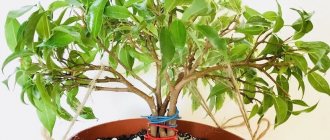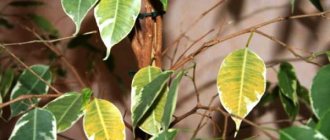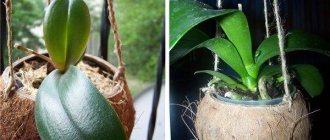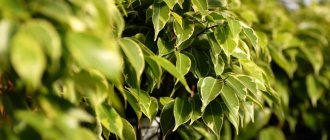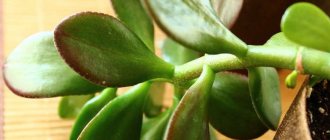Ficus benjamina is an easy-to-grow, small shrub that can now be seen in many homes. Its popularity is due to its fairly simple care, the ability to make beautiful Bonsai from the plant, you can look at the photo and learn how to create them here, this tree is also easy to propagate and will perfectly decorate the interior of any home. But even this unpretentious plant needs certain rules of care; some problems may arise. Many gardeners have questions about why the shrub stops growing and how to properly care for it. Below we will answer you why your pet does not want to grow, what he needs at home.
Finding the right place
Ficus Benjamina does not like too dry air, too high temperatures, or drafts. Very often this can cause growth retardation at home. Darkness has a bad effect on the shrub; because of this, leaves may fall off in winter; bright light is needed, but direct sunlight should not be allowed.
Recommendations for where to place it: • The humidity of the air where the tree is located should exceed 50%; you should regularly spray the leaves with a spray bottle. • The air temperature in the room should not be higher than 25 degrees, but at the same time it must not fall below 15 degrees. • Place the pot at least two meters away from the radiators. • You cannot place a seedling next to open windows or doors; it does not react well to drafts, because of this, growth slows down and leaves may turn yellow and fall off. • Choose a place where the entire crown will be constantly and evenly illuminated, but there is no direct sun. • Do not move the tree from place to place too often; it does not like to be constantly moved.
Why ficus benjamina and other species grow poorly
There may be one reason or caused by a whole complex of minor defects in care. To find out why the ficus stopped growing, you first need to rule out normal aging. The culture will live in the apartment for about 15 years, then it will first slow down and then stop developing, begin to turn yellow and shed its leaves. The branches will begin to dry out, starting with the smallest tree-like forms, and the rubber-bearing ones will simply wither away.
Of course, among all types of ficus there are long-livers. If from the moment of purchase they were provided with ideal care, cool wintering, regular transplants and constant high humidity.
The old specimen will still grow poorly, nothing can be done here. Unless you carry out drastic pruning and give a killer dose of stimulants. But when the ficus is beautiful, it is better not to do this - the decorative effect is lost for several years, and there is no guarantee whether it will be possible to restore the crown.
Other reasons for slowing or stopping growth:
- poor or improper feeding;
- insufficient and excessive watering;
- little or a lot of light;
- ficus will not grow normally in a pot that is too loose, or if the root has occupied almost the entire volume;
- a transplant has not been performed for a long time;
- low air humidity;
- damage by pests and diseases;
- temperature violation;
- frequent reshuffles.
We water our pet correctly!
Since Ficus Benjamin is still a woody plant that lives according to the seasons, there are also watering features here. Remember, if you overdry or, on the contrary, overwater, the leaves of the tree may begin to fall off.
[ads-pc-1]
Recommendations for watering at home: • At different times of the year, shrubs have different watering schedules. In the summer we irrigate at least twice a week, making sure that the soil is slightly dry before the next watering, since at this time the Benjamin variety begins to grow quickly. In winter, we reduce watering to once a week or every 10 days. • Drain excess water from the tray. • You cannot create a “swamp” in a pot. • It is better to settle the water for humidification; it should be at room temperature. In the video you can see how to water correctly.
What could have influenced it?
Factors that negatively affect plant life include:
- lack or excess of lighting;
- violation of thermal conditions;
- not very suitable watering regime;
- frequent rearrangement of the flower;
- lack of nutrients or oversaturation of fertilizers.
If their impact is not eliminated in time, the ficus may die.
Bad light
If there are errors in the organization of the light regime, the flower develops slowly from the very beginning. It's noticeable right away.
The most common violations:
- location of the pot on the shady side;
- getting burns due to increased contact with direct rays of the sun;
- placing a ficus on a south-facing window sill.
Interesting! Varieties with variegated leaves need more light than dark green varieties.
Incorrect humidity and temperature conditions
Failure to comply is expressed as follows:
- room climate is too dry;
- rare frequency of spraying and accumulation of dust on the surface of the leaves;
- proximity of heating devices;
- keeping in cold or stuffy conditions.
Temperatures within +19-26 degrees with air humidity up to 70% are considered optimal.
To maintain the normal functioning of the flower, it is recommended to wash it once a month under a warm shower. This is not only additional hydration. This removes parasites and dirt particles from the surface of the crown.
Frequent change of place
It is enough to neglect the care requirements once to harm the plant.
Regularly moving the tree pot leads to negative consequences:
- the flower does not have time to adapt to the new microclimate;
- these conditions are not suitable for the ficus, so the crown begins to thin out;
- the metabolic process slows down.
It is better to immediately allocate a specific place for the tree and change it only as a last resort.
Watering
During the irrigation process, it is worth considering some nuances:
- the flower tolerates drought normally, but does not tolerate complete drying out of the soil or its cracking;
- if you over-water the roots, the process of rotting will begin;
- Do not water with cold and unsettled water.
If these care rules are not followed, the plant may wither.
In winter, the tree should be watered no more than twice a week. In summer it is better to do this as the soil dries out. If the room temperature is not higher than +15, you should temporarily avoid moistening the soil.
Pests and diseases
The presence of parasites is immediately noticeable. When they appear, the leaves curl into a tube, wither and become covered with spots. At the same time, the leaf plates also become sticky. You can see larvae or white coating on them. This is often accompanied by slower growth because insects take nutrients from the plant.
They can harm him:
- spider mite;
- aphid;
- scale insect;
- mealybug.
Parasites are caused by improper care. In rare cases, pests enter the apartment along with the purchased flower.
Important! When visiting a flower shop, you need to carefully examine the inner surface of the leaves and assess the general condition of the plant. A good preventive measure against parasites is spraying with soapy water and a warm shower.
Ficus can also be threatened by infections and fungal diseases. These include powdery mildew and anthraciasis. But the most dangerous are root and gray rot.
When and how to change the pot for our Flower
The roots of seedlings at home grow quite quickly. In this regard, young specimens need to change their containers once a year. For trees older than 4 years, we change the pot once every 1-3 years, as the roots completely fill the container in which they live.
Recommendations for proper transplantation: • Choose a pot 2-3 centimeters larger than the previous one. If the container is too large, the flower will develop too slowly, all energy will be spent on developing a powerful root system. • We replant only in spring or summer. At other times, the bush either gains strength or comes to a dormant state. • Before transplanting, the seedling needs to be watered. • In a new pot, at the bottom we make drainage from small pebbles (as in the photo below), otherwise excess water will stagnate, sprinkle them with earth on top. • Carefully remove the tree from the old container so that the entire lump of soil is preserved. • It is necessary to slightly remove the top layer from the lump of soil, since the soil there has already been depleted. • We plant our lump in the prepared tub, sprinkle all the cavities with the prepared soil. • We compact the soil a little with our hands.
If the pot is more than 30 cm in diameter, you can refuse to replant; just remove the top layer of soil, as in the photo below, and add new soil containing 20% organic fertilizers.
Most often, the answer to the question of why growth slows down is that the pot is too large.
How to speed up the growth of Ficus Benjamin
If the care is regulated, the place is chosen correctly, it has not been changed for a long time, and a healthy ficus does not grow and stands still, it needs to be stimulated artificially. Of course, in winter all processes are suspended, and you will have to wait until spring for new leaves or shoots to appear.
Transplants
To speed up growth, it is first recommended to transplant the ficus. It is better to carry it out when the beginnings of new leaves appear, at the very beginning of the growing season. The diameter of the pot should be 2-4 cm larger than before, even if the old ficus was too crowded. It is better to skip a season and wait for rapid growth in the next one than to lose a flower due to acidification of the soil.
It is recommended to change the substrate to another brand, not to make it yourself, and to refuse “improvements” with any components. It is also advisable not to use the universal one - there is nothing wrong with it, but the intended soil for ficus and palm trees is still better.
Sometimes gardeners shorten the roots of plants when replanting. For some crops and bonsai this is quite justified, but for ficus trees it is absolutely not suitable. They will stop growing for at least a season, and may even die.
Feeding
Accelerating growth processes with nitrogen alone is a mistake. There is a high probability that there will be a disproportion between the development of the above-ground part of the plant and the root, which needs phosphorus. This will not lead to anything good.
It is better not to increase the intensity of fertilizing, but to replace the cheap fertilizer for ficus with a good brand, and take only the liquid form. Crystals and powder, no matter what the manufacturers claim, do not completely dissolve; a sediment forms at the bottom, even if this is not visible to the naked eye.
When it remains at the bottom of the watering can, the plant does not receive enough fertilizer and is poured into the soil - the ficus receives shock from burning the roots. Even if this does not lead to the shedding of leaves, the flower will not grow for some time. And then he will receive a new portion of feeding.
It is better to give microelements in chelated form - this is the only way to ensure a sufficient supply of iron, manganese, zinc, copper, and molybdenum. They are not absorbed through the root, but settle in the soil or on the walls of the pot, forming a coating.
In winter, all feeding is stopped. During the rest period, they will bring nothing but harm. Unless the room temperature is high, but this is bad in itself, especially with low humidity.
Stimulants
At the beginning of the growing season, the ficus can be watered or treated with a stimulant. One, and not all that we managed to buy in the nearest store.
An excellent remedy is 1 tablespoon of vodka per glass of water. The plant gets a good shake-up, but this is exactly the case when stress is beneficial. Suitable for flowers that sit still for some unknown reason.
Expert opinion from the site Your Flower
Galina Alexandrovna
More than 30 years of experience in growing indoor and garden flowers
Ask a Question
If your ficus leaves are dull, it may be lacking oxygen. In addition to loosening the soil the next day after moistening, it is recommended to dissolve 2 tbsp in a liter of water. l. hydrogen peroxide, water and spray the plant.
When the reason is determined correctly, it will give results not the next day. There was an error - it won't get any worse.
Epin and zircon are excellent products. But it is recommended to use them not when the stress factor has occurred, but before it. For example:
- on the eve of pruning;
- on the eve of winter;
- a few days before the onset of cold weather or extreme heat;
- before going on vacation, when there is no confidence that the ficus will be provided with decent care.
Let's feed our ficus
Like any plant planted at home, ours also needs feeding. This is due to the fact that as the tree grows, it quickly takes all the nutrients from the soil.
Recommendations for fertilization: • Fertilize in spring and summer, once every two weeks. • Benjamin loves liquid fertilizers, both organic and mineral. • You can use wood ash or nettle infusions for better growth. • We fertilize only after preliminary watering, so as not to burn the roots. The video below shows the feeding process in more detail.
Features of growing rubber ficus
The rubber ficus, grown under artificial conditions, is a strong tree with large, bright green, leathery, elliptical leaves, pointed at the ends. Its size, of course, is much more modest than that of its counterparts growing in the natural environment.
[ads1]On the leaves of the plant you can sometimes see white droplets of milky juice . If it comes into contact with the skin, the juice can cause irritation or dermatitis, since it contains alkaloids, latex, and enzymes.
The plant uses this property to protect against pests and heal its own damage.
Even in a home or office, the ficus grows incredibly quickly, adding 60-100 cm per year. To limit its growth, the plant is pinched - shoots growing upward are removed, after which the ficus begins to bush - it sends out side shoots and grows in width.
Under comfortable conditions, the rubber-bearing ficus will produce 1 new leaf per week from spring to autumn, without shedding existing leaves.
Attention, the ficus was attacked by parasites!
Diseases can also be an obstacle to cultivation. Both fungi and rot may appear on various parts of the trunk and leaves. Be careful, such “guests” can often not only slow down growth, but lead to death. Below we have selected photos that show the disease.
Types of parasites: 1. Leaf fungus. It manifests itself as black spots on the leaves. After the defeat, the leaves begin to fall off. 2. Gray mold is another pest. It looks like gray mold, which appears if the plant is flooded or the room is too warm. When this disease appears, they can be resuscitated in the following way: remove all affected areas, water less frequently, and do not allow the room to become stuffy. 3. Sooty fungus is a gray coating on the leaves. We wash the infected areas with soapy water at room temperature; if the lesion on the foliage is too large, it is better to get rid of the leaf completely. 4. Root system rot. This is the most dangerous disease; in this case, the seedling itself withers. Unfortunately, the roots cannot be revived. In this case, the bush must be disposed of along with the pot, since it contains mold residues; reproduction in this container is no longer possible.
Failure to follow the rules for fertilizing a flower
Another reason why the ficus stands still may be improper feeding. With their deficiency, the leaves begin to turn yellow and crumble. An excess of fertilizers is even more harmful to the plant. It is indicated by the brown tint of the foliage and its fall.
To prevent the ficus from stopping growing altogether, you should establish a feeding regime. Only the purchased flower needs to be replanted and fertilized. In the future, fertilizing is applied once every 20-30 days. It is important to remember that all-purpose fertilizers do more harm than good to the plant. Therefore, it is necessary to use preparations specifically designed for ficus or palm trees.
The flower reacts well to organic matter. In this case, you can add a mixture of equal parts of poultry droppings, ash and sapropel.
How to care for Natasha and Kinki varieties?
Natasha presents a dwarf variety of Ficus Benjamin; in the photo you can see what it looks like. This is what is most often used when making Bonsai. The difference between this species is the small green leaves, the approximate length of which is 3 cm and the width is 1.5-2 cm. Most often, it is the “Natasha” variety that is characterized by slow growth at home. The basic rules of care are the same as for all representatives of Benjamin, but there are some differences in care. [ads-pc-1]
Features of caring for the ficus “Natasha”, why it stops growing: • You need to wash the crown once every 1-2 weeks, it is advisable to completely immerse the foliage in water for a couple of minutes (do not immerse the pot in water!) • This variety is especially sensitive tolerates frequent changes of location; due to constant movement, leaves may begin to fall. Find out more in the video below.
Kinky, no less popular variety than Natasha. It is also dwarf, but has a light edge around the leaf, as in the photo below. Kinki tolerates crown pruning without complications. Kinka's leaves are about 4-5 cm in length. It is necessary to follow all the rules when caring for this variety, as mentioned above, but this variety is quite whimsical.
Rules for caring for Kinki, why it stops growing: • Sufficient lighting plays a big role in growing this variety, you need a sunny place. In autumn and winter, it would be ideal to use plant lamps to create additional lighting at home. • The tropical variety does not tolerate hypothermia and needs a temperature of about 21-25 degrees. • Air humidity should exceed 60%, spraying with water at room temperature is necessary.
Frequently rearranging the plant
The reason why the ficus is not growing well or has begun to shed its leaves may be that the flower moves too often. Therefore, before purchasing a plant, you need to decide on its permanent location, which will be protected from drafts and located away from radiators and heating devices.
Crown formation, ficus pruning
Pruning is a popular method that allows you to give your ficus benjamina the desired shape. Most often, the following types of crown formation are used for these plants:
- Ball-shaped crown.
- Bush-like.
- In the form of a single or multi-tiered standard.
- Bonsai style.
- In the form of various sculptures.
Experts recommend planning to trim your ficus in spring or early summer , since it is at this time of year that its accelerated growth begins.
When forming the crown, it is necessary to take into account the age of the plant . It is easiest to give the desired crown shape to young specimens. This, in turn, guarantees that as a result of pruning the plant will acquire the required shape.
Pruning Ficus Benjamin is usually considered in relation to those plants that have a fairly overgrown crown, or specimens that, due to their unusually large size, have lost their former attractiveness.
In order to avoid unpleasant consequences after pruning ficus Benjamin, it is necessary to carry out this operation taking into account the following rules:
- try to ensure that after the operation the plant does not lose its naturalness;
- before removing the branches, try to imagine what the ficus will look like without them;
- branches must be removed only with a sterile instrument;
- it is necessary to keep the bark intact;
- When pruning ficus, you must ensure that the leaves are not damaged;
- Ficus branches must be removed at an angle to the top edge.
Ficus grows in length, not width, what to do. How to make a ficus grow wider and not higher
Good afternoon Several years ago I planted a ficus leaf and now it has grown to a height of more than 1 meter.
It looks like 1 trunk and leaves on it. Moreover, it definitely needs support, otherwise it will fall.
Tell me, is it possible to stop the upward growth and direct the growth wider, maybe cut off the top? Thank you!
Tags: ficus
Answer #1
You didn’t indicate what kind of ficus you have??? If the ficus is Benjamin, then yes, your ficus should have been “trimmed” back in childhood. Now you need to cut off the top by 10-15 cm (no more and sprinkle the cut with crushed activated carbon. Place the top in some water and grow a new tree, but trim the top in time. It is enough to wait for four or five young leaves and pluck out the top. Next will come the lateral shoots - the same with them - 4-5 leaves and pinch off the tops. Your tree will be curly.
Moving the pot from place to place
Why doesn't my house ficus grow?
Of course, if a flower suddenly stops growing, many gardeners begin to move it around the room in search of a much more suitable place. But such an approach will not bring anything good. The thing is that it is recommended to choose the optimal location for a home ficus in advance. If you subsequently start moving it and rearranging it, the plant may also lose its leaves. Therefore, the first thing you need to do to grow Ficus Benjamin or the Rubber variety is to determine the ideal location. Take care of your plant: provide proper care for it, and you will not need to deal with illnesses, stunting or loss of leaves.
